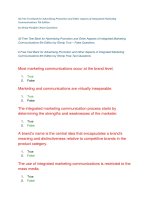Marketing chapter 19 advertising sales promotion and public relations
Bạn đang xem bản rút gọn của tài liệu. Xem và tải ngay bản đầy đủ của tài liệu tại đây (1.44 MB, 64 trang )
CHAPTER
ADVERTISING,
SALES
PROMOTION,
AND PUBLIC
RELATIONS
© 2006 McGraw-Hill Companies, Inc., McGraw-Hill/Irwin
Slide 19-2
AFTER READING THIS CHAPTER
YOU SHOULD BE ABLE TO:
1. Explain the differences between
product advertising and institutional
advertising and the variations within
each type.
2. Describe the steps used to develop,
execute, and evaluate an advertising
program.
© 2006 McGraw-Hill Companies, Inc., McGraw-Hill/Irwin
Slide 19-3
AFTER READING THIS CHAPTER
YOU SHOULD BE ABLE TO:
3. Explain the advantages and
disadvantages to alternative advertising
media.
4. Discuss the strengths and weaknesses of
consumer-oriented and trade-oriented
sales promotions.
5. Recognize public relations as an
important form of communication.
© 2006 McGraw-Hill Companies, Inc., McGraw-Hill/Irwin
Slide 19-4
TYPES OF ADVERTISEMENTS
• Advertising
• Paid, non-personal communication
through various media by
organizations and individuals who
are in some way identified in the
advertising message
• Total advertising volume exceeds
$230B yearly
© 2006 McGraw-Hill Companies, Inc., McGraw-Hill/Irwin
Slide 19-6
TYPES OF ADVERTISEMENTS
• Product Advertisements –
focus on selling a good or service and which
take three forms:
1. Pioneering (or Informational)
2.
Competitive (or Persuasive)
Comparative (relative to competitors)
3.
Reminder (reinforce previous knowledge)
Reinforcement (made the right choice)
© 2006 McGraw-Hill Companies, Inc., McGraw-Hill/Irwin
Slide 19-6
TYPES OF ADVERTISEMENTS
Institutional Advertisements
designed to build goodwill or an image for
an organization rather than promote a
specific good or service
– Often used to support the public relations plan
or counter adverse publicity
© 2006 McGraw-Hill Companies, Inc., McGraw-Hill/Irwin
Slide 19-17
TYPES OF ADVERTISEMENTS
• Institutional Advertisements
Advocacy – state the position of a company
on an issue
Pioneering Institutional – announce what a
company is , what it can do, or where it is
located
Competitive Institutional – promote
advantages of one product class over another
and used in markets where different product
classes compete for same buyers
Reminder Institutional – simply bring
company’s name to attention of target market
again
© 2006 McGraw-Hill Companies, Inc., McGraw-Hill/Irwin
Slide 19-17
DEVELOPING THE
ADVERTISING PROGRAM
•The promotion decision process can be
applied to each of the promotional elements:
A. Identifying the Target Audience
B. Specifying Advertising Objectives
C. Setting the Advertising Budget
© 2006 McGraw-Hill Companies, Inc., McGraw-Hill/Irwin
FIGURE 19-1 Super Bowl, super dollars,
super audience
© 2006 McGraw-Hill Companies, Inc., McGraw-Hill/Irwin
Slide 19-28
DEVELOPING THE
ADVERTISING PROGRAM
•
Designing the Advertisement
– Message focuses on key benefits of
product that are important to prospective
buyers
– Message depends on general form or
appeal used in ad and actual words
included in the ad
1. Message Content
2. Creating the Actual Message
© 2006 McGraw-Hill Companies, Inc., McGraw-Hill/Irwin
Slide 19-31
DEVELOPING THE
ADVERTISING PROGRAM
1. Message Content
– Most advertising messages are made up
of both informational and persuasional
messages
– Information – product name, benefits,
features, and price – presented in a way
to attract attention and encourage
purchase
© 2006 McGraw-Hill Companies, Inc., McGraw-Hill/Irwin
Slide 19-31
DEVELOPING THE
ADVERTISING PROGRAM
1. Message Content, cont.
A. Fear Appeals
– Consumers can avoid some negative
experience through the purchase and use
of a product or service, a change in
behavior, or a reduction in the use of a
product
– Advertisers must be sure that appeal is
strong enough to get consumers’
attention and concern but not so strong
that it will lead them to tune out the
message
© 2006 McGraw-Hill Companies, Inc., McGraw-Hill/Irwin
Slide 19-31
DEVELOPING THE
ADVERTISING PROGRAM
1. Message Content, cont.
B. Sex Appeals
–
–
–
–
Suggests to consumers that product will
increase the attractiveness of the user
Can be found in almost any product category
Successful at gaining attention of consumers but
have little impact on how consumers think, feel,
or act, and may even distract them from the ad’s
purpose
Many advertisers have modified content of their
ads based on a recent Super Bowl controversy
© 2006 McGraw-Hill Companies, Inc., McGraw-Hill/Irwin
Slide 19-31
DEVELOPING THE
ADVERTISING PROGRAM
1. Message Content, cont.
C. Humorous Appeals
– Imply either directly or more subtly that
the product is more fun or exciting than
competitor's offerings
– Is widespread and found in many product
categories
– Humor tends to wear out quickly, boring
the consumer
– Effectiveness varies across cultures if
used in a global campaign
© 2006 McGraw-Hill Companies, Inc., McGraw-Hill/Irwin
Slide 19-31
DEVELOPING THE
ADVERTISING PROGRAM
2. Creating the Actual Message
– Many firms use athletes, movie and TV
stars, musicians, and other celebrities to
talk to consumers through their ads
– Advertisers believe that the ads are more
likely to influence sales
– Potential shortcoming is spokesperson’s
image may change
– Many companies now probe potential
endorsers’ background
© 2006 McGraw-Hill Companies, Inc., McGraw-Hill/Irwin
Slide 19-31
ETHICS AND SOCIAL
RESPONSIBILITY ALERT
Who Decides What Is
“Appropriate” Advertising?
© 2006 McGraw-Hill Companies, Inc., McGraw-Hill/Irwin
Slide 19-35
FIGURE 19-A Top 15 advertising slogans of
the 20th century
© 2006 McGraw-Hill Companies, Inc., McGraw-Hill/Irwin
Slide 19-39
FIGURE 19-B Top 10 advertising icons of the
20th century
© 2006 McGraw-Hill Companies, Inc., McGraw-Hill/Irwin
Slide 19-40
FIGURE 19-2 U.S. advertising expenditures,
by category (in millions of dollars)
© 2006 McGraw-Hill Companies, Inc., McGraw-Hill/Irwin
Slide 19-44
DEVELOPING THE
ADVERTISING PROGRAM
Selecting the Right Media
© 2006 McGraw-Hill Companies, Inc., McGraw-Hill/Irwin
DEVELOPING THE
ADVERTISING PROGRAM
• Selecting the Right Media
– Advertising media – means by which the
message is communicated to target
audience; includes newspapers,
magazines, radio, and TV
– Selection decision is related to target
audience, type of product, nature of
message, campaign objectives, available
budget, and costs of alternative media
© 2006 McGraw-Hill Companies, Inc., McGraw-Hill/Irwin
Slide 19-31
DEVELOPING THE
ADVERTISING PROGRAM
• Selecting the Right Media
Choosing a Medium and a Vehicle within
That Medium – conflicting goals
• Maximizing Exposure
• Minimizing Costs
© 2006 McGraw-Hill Companies, Inc., McGraw-Hill/Irwin
Slide 19-43
FIGURE 19-3 The language of the media
buyer
© 2006 McGraw-Hill Companies, Inc., McGraw-Hill/Irwin
Slide 19-46
DEVELOPING THE
ADVERTISING PROGRAM
• Selecting the Right Media
Basic Terms
• Reach – number of different people or households
• Rating – percentage of households in a market tuned in
• Frequency – average number of times a person is
exposed to advertisement
• Gross Rating Points (GRPs)
•Reach (% of total market) x Frequency
• Cost per Thousand (CPM) – individuals or households
•Advertising Cost($) / Impressions Generated (in 1000s)
© 2006 McGraw-Hill Companies, Inc., McGraw-Hill/Irwin
DEVELOPING THE
ADVERTISING PROGRAM
• Different Media Alternatives
Television – sight, sound, and motion – reaches
95% of U.S. homes
• Out-of-Home TV – reaches another 20M viewers
• “Spot” Ads – 10-, 15-, 30-, or 60-second lengths
• Wasted Coverage – people outside the market
• Digital Video Recorders (DVRs) – “30-second skip”
• Infomercials – educational approach
•90 percent of all TV stations air
•25 percent of all consumers have purchased as a
result of seeing
© 2006 McGraw-Hill Companies, Inc., McGraw-Hill/Irwin
Slide 19-47









